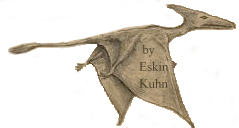The Fiery Flying Serpent of the Bible may have been a long-tailed Rhamphorhynchoid, related to the modern-day ropen. Some ancient reports of long-tailed flying dragons may be of similar species of modern pterosaur, in earlier human history. But for now let’s consider the more recent encounters with these apparent pterosaurs, especially North American sightings.
At the end of 2012, I compiled data from 128 sighting reports, 74% of which I had direct contact with the eyewitnesses, usually involving email communication. In each of these 128 reports, I believed the sighting was more than 50% likely to have been an actual encounter with a living pterosaur. In some cases, I was over 80% sure.
Much has been written on some of the sightings from 1944 through the end of 2012. Let’s now consider more recent reports, all of which were encounters since 2012. This is just a small sampling.
Before getting into those details of particular reports, however, let’s go over some of the statistics.
Of the worldwide sightings (the 128), the ratio of long-tail/lack-of-long-tail is about 20-to-1, namely 41% long-tail and 2% no-long-tail. For those encounters in the contiguous 48 states of the USA, the ratio is not so dramatic, 38% to 5% in favor of long tails, but it is still significant. Ropens dominate in numbers, in the United States of America and elsewhere.
For all 128 of the sightings worldwide, 28.5% of them involved an observation of something like a Rhamphorhynchoid tail flange, with some descriptions including a word like “diamond” (shape). This correlates with the frequent reporting of a long tail on an apparent pterosaur.
Now for a few particular recent sighting reports in North America:
Hanover County, Virginia, sighting in early July of 2015
Three members of a family saw a strange flying creature that brought to their minds the word “dragon.” It had a “large wingspan and long pointy tail.” [contacted Jonathan Whitcomb by email]
Columbia Station, Ohio, sighting in the spring of 2015
“A medium to large bird with no feathers and a long tail with a ball at the end.” [contacted Whitcomb by email]
Richmond, Virginia, sighting in early April of 2015
“It looked to be about 10 feet across and its tail was long with a triangle point!” [two eyewitnesses]
Los Angeles County, California, sighting in December of 2014
“I saw it around 9am this morning today. It was a giant black bird of some types. I live very close to San Fernando and Fletcher but I usually help out my cousin who lives here in Atwater most the week.
“Anyway, after the rain settled I saw this big black bird figure fly over an electrical post. I could compare the size to a couple of pigeons because there was some flying by it. It was just huge. A big beautiful thing. It had a long tail but it was a different color than what was reported. it was black… I think it was a pterosaur. I called the Los Angeles Zoo but they put me on hold and I didn’t want to leave a message.” [email contact with Whitcomb]
.

###
.
Dragon Pterodactyl Living in California
A 38-year-old woman in a residential neighborhood of Lakewood, California, just northeast of Long Beach, reported a “dragon-pterodactyl” that had no feathers but a long tail with a “dragon” “triangle” at the of that tail.
“. . . large wingspan and long pointy tail . . . Wings had the distinct ‘pterodactyl’ architecture on the trailing edge.” [Hanover County, Virginia, early July of 2015]
Pterosaur Sightings Data for the USA
What do I mean by “more credible sightings?” Each sighting report in this compilation (including the 90 here examined) was judged by me to be more than 50% likely to have been an actual encounter with a living pterosaur.
In the United States and British Columbia, with many sightings in the USA
Up until the late 20th Century, the flying fox explanation was used to dismiss reports of large flying creatures in Papua New Guinea, nocturnal creatures that some people called pterodactyls.
The Fiery Flying Serpent and the Ropen
Searching for Ropens and Finding God [the book] is . . . about pterosaurs with long tails, apparently real animals that live in our modern world.
Jonathan Whitcomb’s Ropen Research
The tail is what riveted me, you could see the shape on the end . . . it stuck straight out.
Long-Tailed “Flying Dinosaur” or Ropen
In third-world countries, it is called by many names. In Papua New Guine, the creature may be called “Seklo-bali” or “indava” or “Kor” or “duwas.”
Jonathan Whitcomb in Papua New Guinea
My interpreter Luke Paina and I were there to videotape or photograph a ropen.
Searching for Ropens and Finding God
The prayers of family, friends, and other Americans were answered when I found Luke Paina, who became my interpreter, bodyguard, and counselor.
All seven boys ran home in terror, for that ropen had a mouth “like a crocodile” and a tail that one of the eyewitnesses estimated to be “sefan meetuh” long (about 22 feet).
Sketched by the eyewitness Patty Carson “The Gitmo Pterosaur” or American ropen in Cuba was seen alive in 1965
“Pterodactyl” in New Guinea, in 1944, was apparently a ropen
. . . the same species of flying creature that natives of nearby Umboi Island call “ropen.”
The ropen is described in ways that actually lead to two words: “dragon” and “pterosaur,”
.



